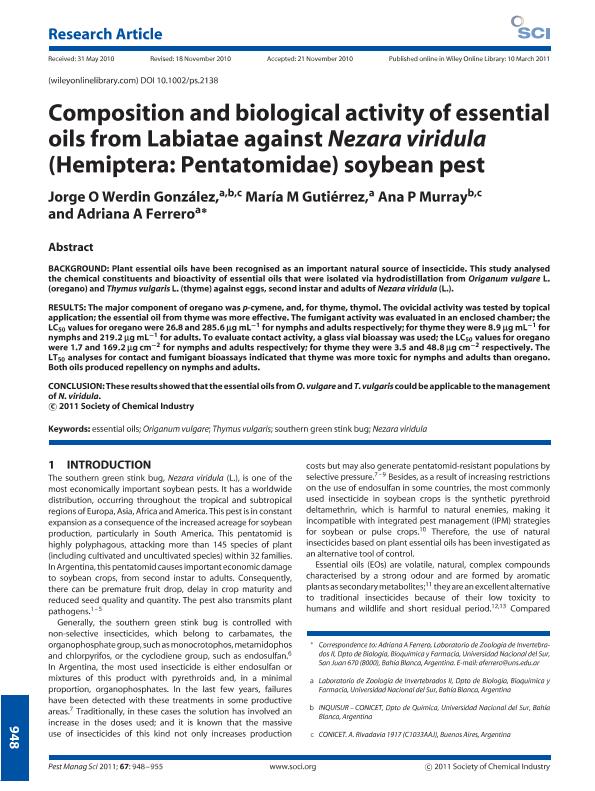Artículo
Composition and biological activity of essential oils from Labiatae against Nezara viridula (Hemiptera: Pentatomidae) soybean pest
Fecha de publicación:
08/2011
Editorial:
John Wiley & Sons Ltd
Revista:
Pest Management Science
ISSN:
1526-498X
Idioma:
Inglés
Tipo de recurso:
Artículo publicado
Clasificación temática:
Resumen
BACKGROUND: Plant essential oils have been recognised as an important natural source of insecticide. This study analysed the chemical constituents and bioactivity of essential oils that were isolated via hydrodistillation from Origanum vulgare L. (oregano) and Thymus vulgaris L. (thyme) against eggs, second instar and adults of Nezara viridula (L.). RESULTS: The major component of oregano was p-cymene, and, for thyme, thymol. The ovicidal activity was tested by topical application; the essential oil from thyme was more effective. The fumigant activity was evaluated in an enclosed chamber; the LC 50 values for oregano were 26.8 and 285.6 μg mL -1 for nymphs and adults respectively; for thyme they were 8.9 μg mL -1 for nymphs and 219.2 μg mL -1 for adults. To evaluate contact activity, a glass vial bioassay was used; the LC 50 values for oregano were 1.7 and 169.2 μg cm -2 for nymphs and adults respectively; for thyme they were 3.5 and 48.8 μg cm -2 respectively. The LT 50 analyses for contact and fumigant bioassays indicated that thyme was more toxic for nymphs and adults than oregano. Both oils produced repellency on nymphs and adults. CONCLUSION: These results showed that the essential oils from O. vulgare and T. vulgaris could be applicable to the management of N. viridula.
Archivos asociados
Licencia
Identificadores
Colecciones
Articulos(INQUISUR)
Articulos de INST.DE QUIMICA DEL SUR
Articulos de INST.DE QUIMICA DEL SUR
Citación
Werdin Gonzalez, Jorge Omar; Gutiérrez, María M.; Murray, Ana Paula; Ferrero, Adriana Alicia; Composition and biological activity of essential oils from Labiatae against Nezara viridula (Hemiptera: Pentatomidae) soybean pest; John Wiley & Sons Ltd; Pest Management Science; 67; 8; 8-2011; 948-955
Compartir
Altmétricas




